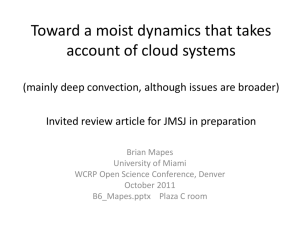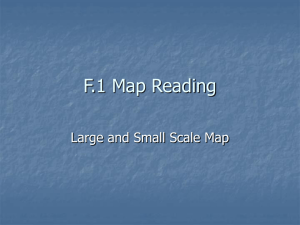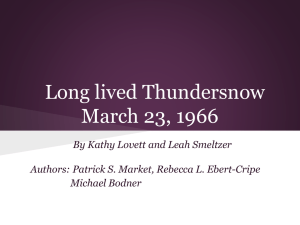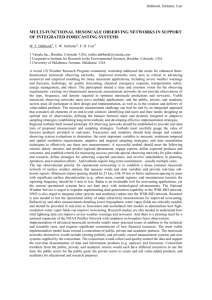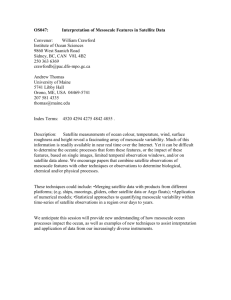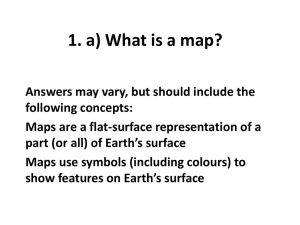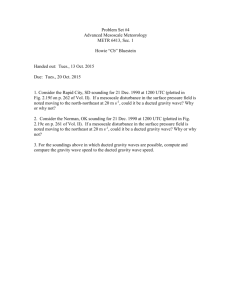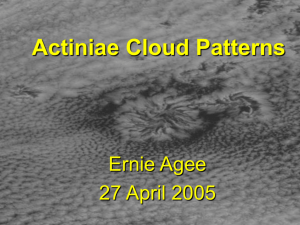Stumpf_M835_PPT1
advertisement
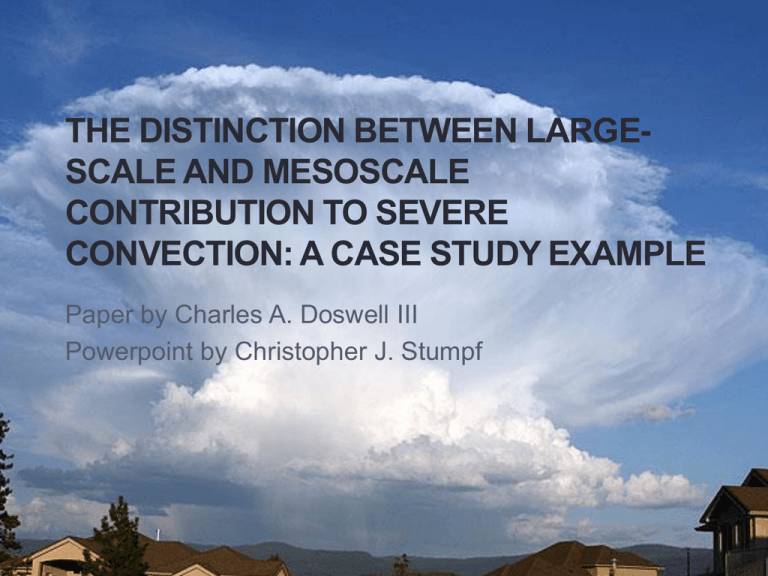
THE DISTINCTION BETWEEN LARGESCALE AND MESOSCALE CONTRIBUTION TO SEVERE CONVECTION: A CASE STUDY EXAMPLE Paper by Charles A. Doswell III Powerpoint by Christopher J. Stumpf The May 6th 1983 Topeka, KS Tornado • A Squall line moved through on the evening of the 6th • Embedded in the squall a tornadic storm formed leaving 1 fatality and injuring 25 people, the tornado was rated an F3 • To determine what caused this storm to develop me must understand both the large-scale and mesoscale processes on this day Differences between Large-Scale and Mesoscale definitions and terms • Large-Scale Processes • Synoptic and sub-synoptic • Mesoscale Processes • Thermodynamic environment • Usually separated on an order of magnitude basis • How do we distinguish between where large scale end and mesoscale begins? Distinguishing between large-scale and mesoscale • Large-scale processes can be restricted to: • Adiabatic • Hydrostatic • Mass continuity must be satisfied • Advection is dominated by the geostrophic wind • Variation of Coriolis parameter is insignificant • Quasi-geostrophic forcing • Omega equation • Height tendency Mesoscale Processes • Mesoscale stands in between large and small scales • Defined as processes which cannot be understood without considering the large scale and microscale processes Defining the Roles of Large-Scale and Mesoscale Processes • Deep Moist Convection can be broken down into three ingredients • Moisture • Conditional Instability • Source of lift • Moisture and Instability can be combined in CAPE. • However, lift needs to be addressed separately Lift • Rarely is the environment completely unstable • Significant lift is required to overcome the negative buoyancy before a rising air parcel can reach its LFC • Large-Scale vertical motions (cm/s) are simply too small to accomplish the needed lift in a reasonable time • Large-scale processes however setup the environments necessary for convection to occur but do not initiate convection Dynamic and Thermodynamic Factors • A. Large Scale Setting • 850 and 500 mb analysis • Surface low pressure • Topeka, KS Sounding • Limited-Area, Fine-Mesh Model (LFM) analysis • B. Sub-synoptic Features • Thunderstorms near NE and KS border • Dryline in Western KS, OK and TX • Sfc. Pressure Rises Large Scale Setting 850 mb Analysis • Large scale cyclogenesis indicated by negative tilting trough • Strong low-level jet Large Scale Setting 500 mb Analysis Surface Analysis at 1200 UTC Convective Inhibition • Strong capping inversion in place • Modest low-level moisture • Dewpoints at or below 50⁰F • Can these negative factors be overcome? 12 and 00 UTC Topeka, KS Soundings LFM Analysis Dynamic and Thermodynamic Factors • A. Large Scale Setting • 850 and 500 mb analysis • Surface low pressure • Topeka, KS Sounding • Limited-Area, Fine-Mesh Model (LFM) analysis • B. Sub-synoptic Features • Thunderstorms near NE and KS border • Dryline in Western KS, OK and TX • Sfc. Pressure Rises Visible Satellite Image 2130 UTC Surface Analysis at 2100 UTC Cold Front Strengthening Vis. Satellite Image at 0000 UTC Quasi-Geostrophic Frontogenesis Summary of Event • The large-scale processes on this day established the environment needed for deep moist convection • However the vertical motion was not sufficient enough to initiate the convection solely by large-scale forcing • Mesoscale processes were needed to initiate the deep convection • Dryline combined with advancing cold front created enough vertical motion to overcome the negative buoyancy • The convection/clouds over NE and clear skies in KS allowed for differential heating to take place Summary of Event • The boundary/front was established by mesoscale processes • After its development the subsequent march across KS was done by large-scale processes/cyclogenesis • Large-scale dynamic processes are not the trigger to convection • The triggers are the mesoscale processes Questions? Quasi-Geostrophic forcing for vertical motion Connection between Dynamics and Thermodynamics • Dynamics: large-scale, quasi-geostrophic forcing • Result in increased lapse rates • Its easier to lift air when the lapse rates are large • Thermodynamics: combination of moisture and lapse rate distributions which makes deep moist convection possible Surface Analysis at 1200 UTC Yes a few equations • Omega equation can be rewritten in terms of Q-Vector Divergence • This combines differential vorticity and thickness advection into one term
